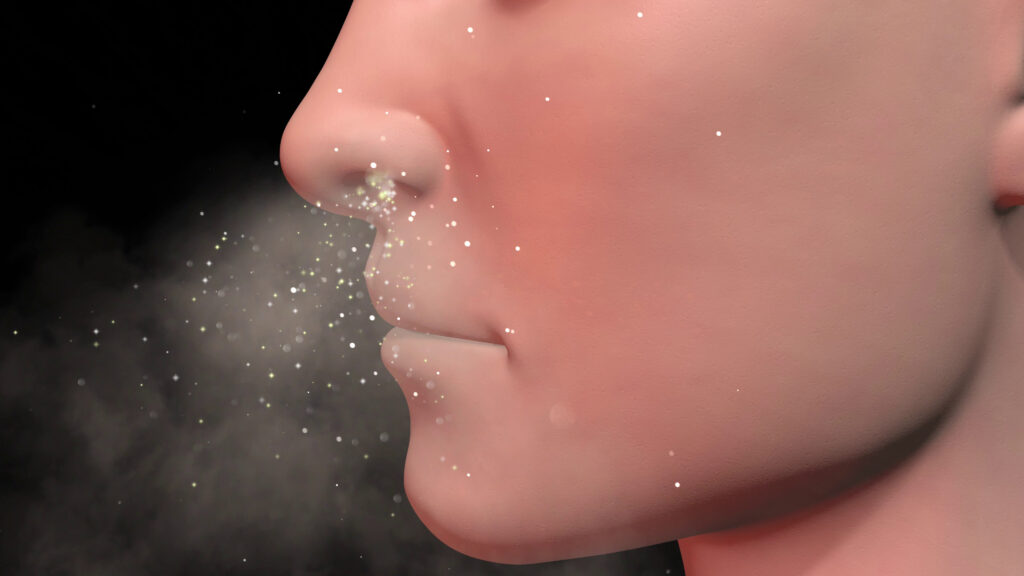Testing Air Quality for Asthmatics in Homes and Workplaces
For individuals with asthma, ensuring good air quality in both their homes and workplaces is of paramount importance. Asthmatics are more vulnerable to respiratory distress caused by factors such as toxic molds, chemicals (VOCs), noxious gasses, particulate matter, dust mites, poor airflow, and odors (mVOCs).
This blog delves into the critical need for testing air quality in environments where asthmatics spend their time. We will explore how poor indoor air quality can contribute to asthma development in children and the lifelong health issues it presents. Furthermore, we will highlight the testing process and equipment employed by IndoorDoctor, demonstrating how our expertise can help asthmatics live and work in the healthiest possible environment.

Asthma and Vulnerability to Respiratory Distress
Asthma, a chronic respiratory condition, leaves individuals more susceptible to respiratory distress when exposed to certain environmental factors. For asthmatics, the airways become inflamed and narrow, making it difficult to breathe. This heightened sensitivity makes them particularly vulnerable to various triggers that can exacerbate their symptoms and lead to respiratory distress.
Toxic molds, commonly found in damp or poorly ventilated environments, release spores that can trigger asthma attacks. These molds produce allergens and irritants that can cause inflammation, resulting in breathing difficulties and increased asthma symptoms.
Chemicals called volatile organic compounds (VOCs) can also pose a significant risk to asthmatics. VOCs are released from various sources, such as cleaning products, paints, solvents, and building materials. When inhaled, they can irritate the airways and trigger asthma symptoms.
Additionally, exposure to toxic gasses, such as nitrogen dioxide and sulfur dioxide, commonly found in polluted environments, can worsen respiratory distress in asthmatics. These gasses can inflame the airways and lead to coughing, wheezing, and shortness of breath. Particulate matter, such as fine dust and allergens, can also aggravate asthma symptoms by triggering inflammation and narrowing of the airways. Dust mites, a common allergen in household dust, can be particularly troublesome for asthmatics.
Poor airflow and inadequate indoor ventilation can further compound asthmatics’ respiratory issues. Stagnant air can trap pollutants, allergens, and irritants, increasing the risk of asthma attacks. The presence of odors, such as mold volatile organic compounds (mVOCs), can also contribute to respiratory distress in asthmatics. These odorous compounds emitted by molds and other sources can trigger asthma symptoms and cause discomfort.
Understanding these triggers and their impact on asthmatics is crucial for creating a healthier living and working environment. By identifying and addressing these factors, individuals with asthma can better manage their condition and reduce the risk of respiratory distress.

Linking Asthma and Poor Indoor Air Quality
The link between inadequate indoor air quality and the emergence of asthma, particularly among children, is due to numerous factors. Studies show that exposure to indoor pollutants and allergens markedly heightens the probability of asthma inception in early childhood. Further, inadequate ventilation, elevated humidity levels, and the insidious presence of mold, dust mites, pet dander, and tobacco smoke collectively contribute to the worsening and initiating asthma symptoms of adults. The repercussions of asthma resonate profoundly, leading to compromised lung function, recurrent respiratory infections, and an impinged quality of life.
Addressing poor indoor air quality serves as a pivotal deterrent against the development of asthma and aids in the effective management of pre-existing cases. Moreover, it is essential to acknowledge that the ramifications of inadequate indoor air quality extend beyond the confines of individuals already grappling with asthma. Adopting a proactive approach to fostering a healthy indoor space benefits everyone, promoting respiratory well-being for all.
The Testing Process and Equipment for Asthmatics
The testing process and equipment used to assess air quality for asthmatics are crucial for identifying potential triggers and ensuring a healthier living and working environment. Asthma-specific testing involves comprehensive assessments of indoor air pollutants, allergens, and irritants. Highly skilled professionals employ state-of-the-art equipment, including specialized air sampling devices and particle counters, to measure particulate matter, volatile organic compounds (VOCs), and other harmful substances.
IndoorDoctor, a reputable provider in this field, utilizes advanced testing methodologies to detect and quantify asthma-related pollutants accurately. Our expertise lies in conducting thorough inspections and employing cutting-edge equipment like high-efficiency particulate air (HEPA) filters and air quality monitors. This allows for precise monitoring of air quality parameters and identification of potential sources of contamination.
By implementing such rigorous testing procedures, asthmatics can gain invaluable insights into the air they breathe. This empowers them to make informed decisions about environmental improvements, ventilation enhancements, and effective mitigation strategies to alleviate asthma symptoms. Testing and monitoring are pivotal in tailoring solutions designed to create a safer and healthier indoor environment for asthmatics, promoting better respiratory health and quality of life.

Creating Healthy Environments for Asthmatics
Creating healthy environments for individuals with asthma is crucial to minimize their exposure to triggers and promote better respiratory health.
Firstly, maintaining good indoor air quality is crucial. This includes regular ventilation to ensure proper airflow and reduce the concentration of indoor pollutants. Air purifiers with high-efficiency particulate air filters also remove allergens and pollutants. Next, addressing moisture and mold issues is essential. Keeping indoor spaces dry and preventing water leaks can prevent the growth of mold, which is a potent asthma trigger.
Reducing the presence of dust mites and pet dander through frequent cleaning, vacuuming with HEPA filters, and using allergen-resistant bedding can significantly improve air quality for asthmatics. Further, choosing low-VOC (volatile organic compound) products for cleaning, painting, and furnishing can help minimize the release of harmful chemicals.
Regular maintenance and cleaning of home HVAC systems and air ducts are also crucial to prevent dust, allergens, and pollutants accumulation. By implementing these measures, individuals with asthma can create healthier environments that minimize their exposure to triggers, reducing the frequency and severity of asthma symptoms and improving their overall well-being.

Protect Indoor Air Quality for Asthmatics
Promoting a healthy environment for asthmatics is essential in managing their condition and improving their quality of life. By taking proactive steps to address indoor air quality, such as conducting comprehensive testing, implementing ventilation improvements, and mitigating potential triggers, individuals with asthma can breathe easier and experience fewer asthma-related complications.
For professional assistance in assessing and improving indoor air quality, IndoorDoctor offers specialized services and expertise. Don’t wait to create a healthier space for yourself or your loved ones—contact IndoorDoctor today and take a step towards better respiratory health.
References
- Agency for Toxic Substances and Disease Registry (ATSDR). Managing Asthma: A Guide for Schools (Second Edition). Available at: https://www.atsdr.cdc.gov/csem/asthma/treatment_management_prevention.html
- Gupta RS, Zhang X, Sharp LK, Shannon JJ, Weiss KB. Seasonal Differences among Early-Life Wheezers and Non-Wheezers. J Pediatr. 2012;161(6):1077-1082.e1. doi:10.1016/j.jpeds.2012.06.027. Available at: https://www.ncbi.nlm.nih.gov/pmc/articles/PMC3719490/
- Heinrich J, Hoelscher B, Frye C, et al. Ambient Air Pollution and the Prevalence of Asthma in German Children: A National Cross-Sectional Study. Environ Health Perspect. 2019;127(4):047005. doi:10.1289/EHP3876. Available at: https://www.ncbi.nlm.nih.gov/pmc/articles/PMC7665158/
- Heinrich J, Hoelscher B, Wichmann HE. Decline of Ambient Air Pollution and Respiratory Health Effects in Children. Eur Respir J. 2010;36(6):1270-1277. doi:10.1183/09031936.00123809. Available at: https://erj.ersjournals.com/content/36/6/1270
- Langer S, Bekö G, Weschler CJ, et al. Indoor Air Quality in Seven Danish Schools – The Influence of Building design, Ventilation and Cleaning Interventions. Indoor Air. 2020;30(5):879-892. Available at: https://www.ncbi.nlm.nih.gov/pmc/articles/PMC7121502/
- Strickland PT, Darrow LA, Mulholland JA, et al. Associations between Ambient Air Pollution and Daily Mortality among Residents of the Inland Northwestern United States. Environ Health Perspect. 2009;117(9):1425-1430. doi:10.1289/ehp.0800205. Available at: https://www.ncbi.nlm.nih.gov/pmc/articles/PMC9536399/
- U.S. Environmental Protection Agency. Links between Air Pollution and Childhood Asthma. Available at: https://www.epa.gov/sciencematters/links-between-air-pollution-and-childhood-asthma




